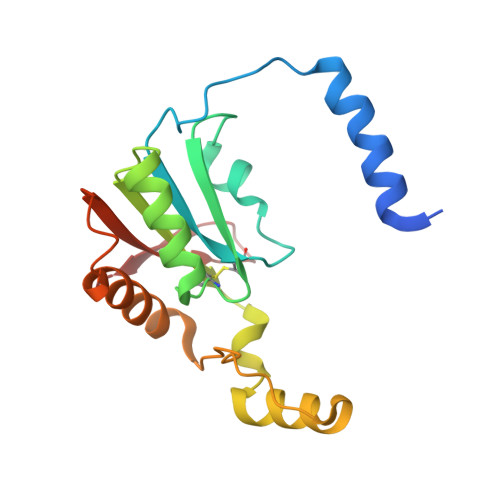Chemical probing suggests redox-regulation of the carbonic anhydrase activity of mycobacterial Rv1284.
Nienaber, L., Cave-Freeman, E., Cross, M., Mason, L., Bailey, U.M., Amani, P., A Davis, R., Taylor, P., Hofmann, A.(2015) FEBS J 282: 2708-2721
- PubMed: 25929542
- DOI: https://doi.org/10.1111/febs.13313
- Primary Citation of Related Structures:
4YF4, 4YF5, 4YF6 - PubMed Abstract:
The mycobacterial enzyme Rv1284 is a member of the β-carbonic anhydrase family that is considered essential for survival of the pathogen. The active site cavity of this dimeric protein is characterized by an exceptionally small volume and harbours a catalytic zinc ion coordinated by two cysteine and one histidine residue side chains. Using the natural products polycarpine and emodin as chemical probes in crystallographic experiments and stopped-flow enzyme assays, we report that the catalytic activity can be reversibly inhibited by oxidation. Oxidative conditions lead to the removal of one of the active site cysteine residues from the coordination sphere of the catalytic metal ion by engagement in a disulfide bond with another cysteine residue close by. The subsequent loss of the metal ion, which is supported by crystallographic analysis, may thus render the protein catalytically inactive. The oxidative inhibition of Rv1284 can be reversed by exposing the protein to reducing conditions. Because the physical size of the chemical probes used in the present study substantially exceeds the active site volume, we hypothesized that these compounds exert their effects from a surface-bound location and identified Tyr120 as a critical residue for oxidative inactivation. These findings link conditions of oxidative stress to pH homeostasis of the pathogen. Because oxidative stress and acidification are defence mechanisms employed by the innate immune system of the host, we suggest that Rv1284 may be a component of the mycobacterial survival strategy. Atomic coordinates and structure factors have been deposited in the Protein Data Bank under accession numbers 4yf4, 4yf5 and 4yf6.
- Eskitis Institute, Griffith University, Nathan, Queensland, Australia.
Organizational Affiliation:



















